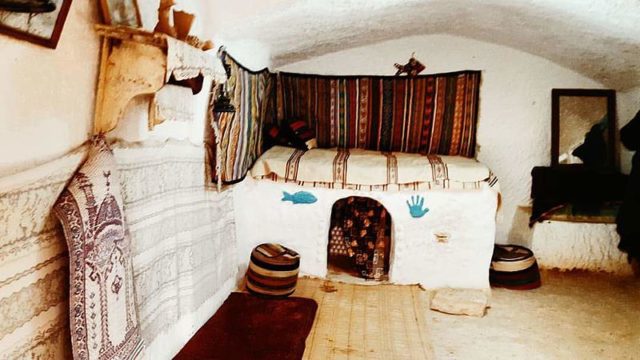Located in the southern end of Tunisia, 25 miles to the southwest of Gabes, the small Berber-speaking town of Matmata is a popular spot for visitors from around the world, thanks to the town’s amazing troglodyte dwellings
These unique structures, typical for the village, are created by digging a large pit in the ground, usually 15 to 30 feet deep. Around the perimeter of this pit, artificial caves are then dug to be used as rooms, with some homes comprising multiple pits connected by trench-like passageways (large enough to allow the passage of both people and animals) forming a large underground maze. Quite remote from any cave-like feeling, the courtyard is a central location for family members to do chores and connect socially.
In some pits, the center is reserved for a well roughly 20 feet deep to tap into the underground water supply. It is a real indication of how people can live in harmony with the harsh desert conditions. The history of this extraordinary place is not known, but it is believed that the city of Matmata has been populated for about 700 years.

The village was originally designed for defensive purposes and was used as a shelter by the Fellagas, groups of armed militants affiliated with anti-colonial movements in French North Africa. These traditional underground troglodyte structures remained hidden for centuries and no one had any knowledge of their existence until 1967. (A troglodyte is by definition a person who lives in a cave.) Since then, the small town of Matmata has made its way into the hearts of travelers.

Unfortunately, intensive rains flooded the houses and caused many of them to collapse. Still, after the flooding, only a few of the families moved to new surface dwellings. Most of the people continued their lives in re-built underground homes. Each cave is outfitted with a bed and some authentic Berber furnishings.

There is even a subterranean hotel that, besides being a unique desert tourist hideaway, was used in 1976 as a filming location for Star Wars Episode IV: A New Hope and the The Phantom Menace (George Lucas used it as Lars Homestead, Luke Skywalker’s childhood home). Designed as a traditional Berber troglodyte underground building, the Sidi Driss hotel consists of a series of small caves and provides traditional troglodyte accommodations for its visitors. There is also a tiny museum, organized as a series of rooms, which offers a history of the town.

This type of architecture can also be found in Libya and Morocco, but no place has so many examples as Matmata.
There are more than 100 dwellings of this kind, but throughout the years, the structures have been outnumbered by normal houses built above ground. In 2004 Matmata had a population of 2,116, but it is estimated that more than 15,000 people once inhabited these pit dwellings.
